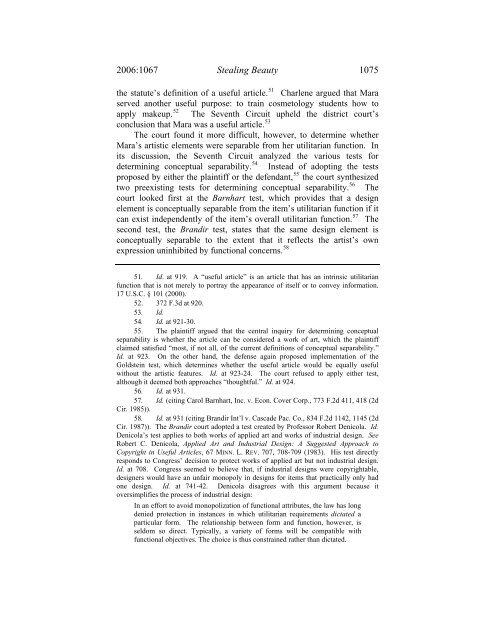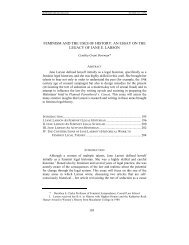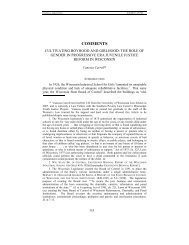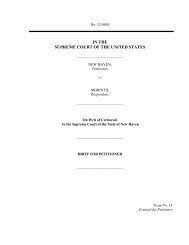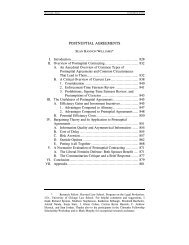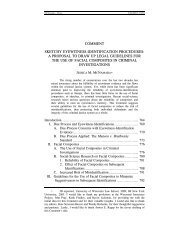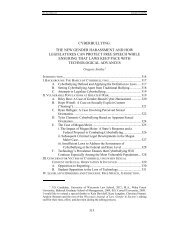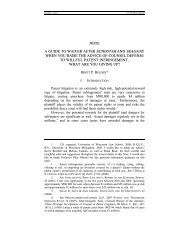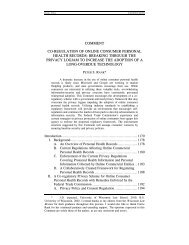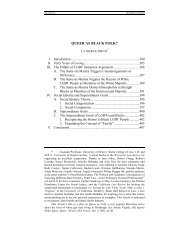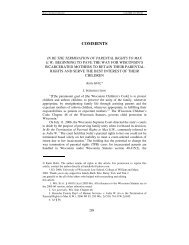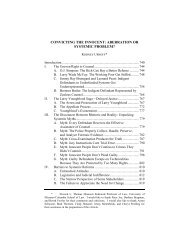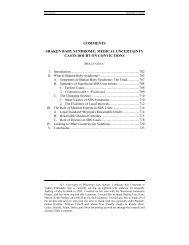Stealing Beauty: Pivot Point International v ... - UW Law School
Stealing Beauty: Pivot Point International v ... - UW Law School
Stealing Beauty: Pivot Point International v ... - UW Law School
You also want an ePaper? Increase the reach of your titles
YUMPU automatically turns print PDFs into web optimized ePapers that Google loves.
2006:1067 <strong>Stealing</strong> <strong>Beauty</strong> 1075<br />
the statute’s definition of a useful article. 51 Charlene argued that Mara<br />
served another useful purpose: to train cosmetology students how to<br />
apply makeup. 52 The Seventh Circuit upheld the district court’s<br />
conclusion that Mara was a useful article. 53<br />
The court found it more difficult, however, to determine whether<br />
Mara’s artistic elements were separable from her utilitarian function. In<br />
its discussion, the Seventh Circuit analyzed the various tests for<br />
determining conceptual separability. 54 Instead of adopting the tests<br />
proposed by either the plaintiff or the defendant, 55 the court synthesized<br />
two preexisting tests for determining conceptual separability. 56 The<br />
court looked first at the Barnhart test, which provides that a design<br />
element is conceptually separable from the item’s utilitarian function if it<br />
can exist independently of the item’s overall utilitarian function. 57 The<br />
second test, the Brandir test, states that the same design element is<br />
conceptually separable to the extent that it reflects the artist’s own<br />
expression uninhibited by functional concerns. 58<br />
51. Id. at 919. A “useful article” is an article that has an intrinsic utilitarian<br />
function that is not merely to portray the appearance of itself or to convey information.<br />
17 U.S.C. § 101 (2000).<br />
52. 372 F.3d at 920.<br />
53. Id.<br />
54. Id. at 921-30.<br />
55. The plaintiff argued that the central inquiry for determining conceptual<br />
separability is whether the article can be considered a work of art, which the plaintiff<br />
claimed satisfied “most, if not all, of the current definitions of conceptual separability.”<br />
Id. at 923. On the other hand, the defense again proposed implementation of the<br />
Goldstein test, which determines whether the useful article would be equally useful<br />
without the artistic features. Id. at 923-24. The court refused to apply either test,<br />
although it deemed both approaches “thoughtful.” Id. at 924.<br />
56. Id. at 931.<br />
57. Id. (citing Carol Barnhart, Inc. v. Econ. Cover Corp., 773 F.2d 411, 418 (2d<br />
Cir. 1985)).<br />
58. Id. at 931 (citing Brandir Int’l v. Cascade Pac. Co., 834 F.2d 1142, 1145 (2d<br />
Cir. 1987)). The Brandir court adopted a test created by Professor Robert Denicola. Id.<br />
Denicola’s test applies to both works of applied art and works of industrial design. See<br />
Robert C. Denicola, Applied Art and Industrial Design: A Suggested Approach to<br />
Copyright in Useful Articles, 67 MINN. L. REV. 707, 708-709 (1983). His test directly<br />
responds to Congress’ decision to protect works of applied art but not industrial design.<br />
Id. at 708. Congress seemed to believe that, if industrial designs were copyrightable,<br />
designers would have an unfair monopoly in designs for items that practically only had<br />
one design. Id. at 741-42. Denicola disagrees with this argument because it<br />
oversimplifies the process of industrial design:<br />
In an effort to avoid monopolization of functional attributes, the law has long<br />
denied protection in instances in which utilitarian requirements dictated a<br />
particular form. The relationship between form and function, however, is<br />
seldom so direct. Typically, a variety of forms will be compatible with<br />
functional objectives. The choice is thus constrained rather than dictated.


